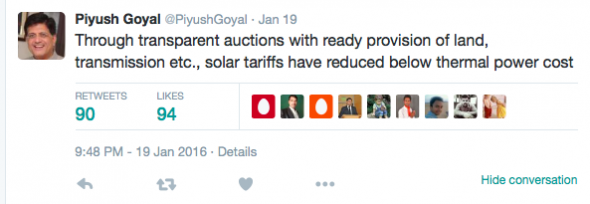Has a tweet made history before?
 Piyush Goyal is India’s Minister of Energy.
Piyush Goyal is India’s Minister of Energy.
To recap. India’s current electricity policy is based on high projections of demand, which is fair enough as 400 million Indians have no electricity at all. The policy on renewables and coal is is “both of the above”. The official coal target is a doubling of coal burning for electricity this decade, and more later. A programme for 16 giant “ultra mega” coal power stations was launched in 2005, though just two have been completed. Adani, Reliance, and Tata, the corporations who would build many of the others, have many shovel-ready projects on their shelves but have been curiously reluctant to break ground on them.
Anecdotal confirmation of major problems in the Indian coal sector comes from this recent report of a developer abandoning plans for a coal plant and replacing it with a solar farm on the same site. Coal stocks at power stations have doubled since last year.
The coal programme is so important to the government that it risked pariah status in Paris by not announcing an emissions cap, even a soft one 15 years ahead like China. India badly wants a seat on the UN Security Council, and being outmanoeuvred and sidelined in Paris by the guy from the Marshall Islands (who? where?) was humiliating. My prediction as to which way Modi would jump was wrong, but not my analysis of his dilemma.
Why? There are several possibilities, not exclusive.
- The current overcapacity (284 GW nominal to 157 GW peak demand) tells companies to wait until the capacity is needed. By the time new capacity is needed, the cost advantage of renewables will be even greater.
- The government has underestimated the gains in electrical efficiency (motors, pumps, compressors, standby, thermostats …) that have led electricity demand to stagnate or fall in OECD countries, and are being reproduced in developing countries.
- The implied increase in coal supply is impossible at prices that make the economics of the UMPPs stand up. Geology and rising wages will only push marginal costs higher.
- Rising renewables, enjoying despatch priority from their negligible marginal cost, will cream off profitable peak loads and lower wholesale prices as well as capacity factors in coal - the German death spiral. Note how the 2003 decision to unbundle the electricity market has let market forces operate; contrast Arizona, Nevada, Georgia and Florida, still shackled to the Gilded Age model of the monopoly silo utility.
- Renewables will become ex-ante substantially cheaper than coal by the time any new coal plants are switched on.
Take your pick. But the facts are clear. Goyal’s tweet means that the latest round of solar auctions in India has blown a hole below the waterline in India’s coal policy. He does not have a choice about reviewing it, since the same data are available to the corporate developers. If the numbers did not convince them to cut ground in 2013 and 2014 and 2015, they won’t look any better in 2016 and 2017. It is a safe prediction that coal burning in India will peak in the next few years, and few if any new coal power plants will be built from now on.

The heavy diplomatic price India paid in Paris is now looking unnecessary. Indian coal will peak of itself in the next few years, shortly followed by total emissions. (Without domestic oil, and with dreadful air pollution in its cities, India has every reason to electrify transport as fast as possible.) There is no reason not to follow China and accept a cost-free emissions cap by say 2025.
Similar data are presumably available to policymakers and businessmen in Turkey, the Philippines and other countries that have been planning to rely on coal expansion. Vietnam has already decided to stop new coal plant projects and review the many in the pipeline.
There is still a chance that both India and China will revise their NDCs before they sign the Paris Agreement, at earliest on 22 April. In any case, global emissions scenarios that treat their old INDCs as likely outcomes are far too pessimistic. King Coal is headed for the guillotine.
Do Indians (e.g., the 400 million with no electricity) burn coal for heat?
Commonsense - coal is geographically concentrated - and brief googling suggest not. From a post by a former Indian government senior official:
So the Indian energy poor rely for cooking and lighting on wood, dung, and kerosene, rather than coal. These generate massive health risks from indoor air pollution, adding to the equally massive damage from outdoor air pollution in cities. I hope Goyal's opposite number in the Ministry of Health is pushing him towards a coal rundown and offgrid solar.
Hurrah, hurrah!!!!
Keep hope alive.